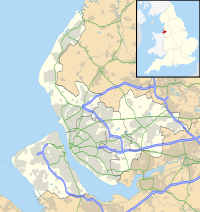Prescot Parish Church
| Prescot Parish Church | |
|---|---|
| Church of St Mary, Prescot | |
 Prescot Parish Church from the east | |
| 53°25′43″N 2°48′23″W / 53.4285°N 2.8063°W | |
| OS grid reference | SJ 465 927 |
| Location | Prescot, Merseyside |
| Country | England |
| Denomination | Anglican |
| Website | Prescot Parish Church |
| History | |
| Status | Parish church |
| Architecture | |
| Functional status | Active |
| Heritage designation | Grade I |
| Designated | 19 March 1951 |
| Architect(s) | Henry Sephton (steeple) |
| Architectural type | Church |
| Style | Gothic |
| Specifications | |
| Materials | Sandstone |
| Administration | |
| Province | York |
| Diocese | Liverpool |
| Archdeaconry | Liverpool |
| Deanery | Huyton |
| Parish | Prescot |
| Clergy | |
| Vicar(s) | Revd Canon John Andrew Taylor |
| Assistant priest(s) | Revd David Rose |
| Curate(s) | Revd Peter Smyth |
| Assistant | Revd Peter Cowley |
Prescot Parish Church, also known as St Mary's Church, is in the town of Prescot, Merseyside, England. It is recorded in the National Heritage List for England as a designated Grade I listed building,[1] and is an active Anglican parish church.[2]
History
The circular shape of the churchyard suggests that a church was on the site before the Norman Conquest, and parts of the existing fabric in the chancel and north vestry date possibly from the 15th century.[3] The church was largely rebuilt in 1610. The tower was built in 1729 and the spire added in 1797.[2] The tower and spire were designed by Henry Sephton, the spire being rebuilt after a lightning strike. The aisles were widened between 1817 and 1819, a restoration took place in 1876, and the south vestry was added in 1900.[3] In 1953 the aisles were rebuilt.[citation needed]
Architecture
The church is built in red sandstone.[3] Its plan consists of a west tower, a nave with a clerestory, north and south aisles and a chancel with north and south vestries. The tower has a west entrance with a three-light window above and an inscribed frieze. The bell stage has Doric flat pilasters and an entablature, 2-light louvred bell openings, and clock faces. The parapet has a balustrade and three finials to each angle, and the spire has three tiers of lucarnes. The aisles have cornices and embattled parapets.[1]
Internally are five-bayed arcades. Stone plaques on the walls carry the arms and sometimes the initials of the 1610 benefactors. The stalls, with poppyhead carving, are dated 1636. The reredos is of panelled timber, dated 1891 and designed by Kempe. There are two fonts, one Norman and simple on a modern base, the other, which was donated in 1755, was previously an Italian marble stoup. The chancel screen is dated 1921. The stained glass includes some in the south aisle by Morris & Co. There are a number of monuments, including one dated 1803 by Sir Richard Westmacott, and a brass dated 1836 which was designed by A. W. N. Pugin.[3]
External features
The churchyard contains the war graves of 24 service personnel, 22 of World War I and two of World War II.[4]
See also
References
- ^ a b Historic England. "Church of St Mary, Prescot (1199139)". National Heritage List for England. Retrieved 19 August 2012.
- ^ a b Prescot Church, Prescot Parish Church, retrieved 2008-05-02
- ^ a b c d Pollard, Richard; Nikolaus Pevsner (2006), Lancashire: Liverpool and the South-West, The Buildings of England, New Haven & London: Yale University Press, pp. 540–542, ISBN 0-300-10910-5
- ^ PRESCOT (ST. MARY) CHURCHYARD, Commonwealth War Graves Commission, retrieved 4 February 2013
External links
![]() Media related to Prescot Parish Church at Wikimedia Commons
Media related to Prescot Parish Church at Wikimedia Commons

